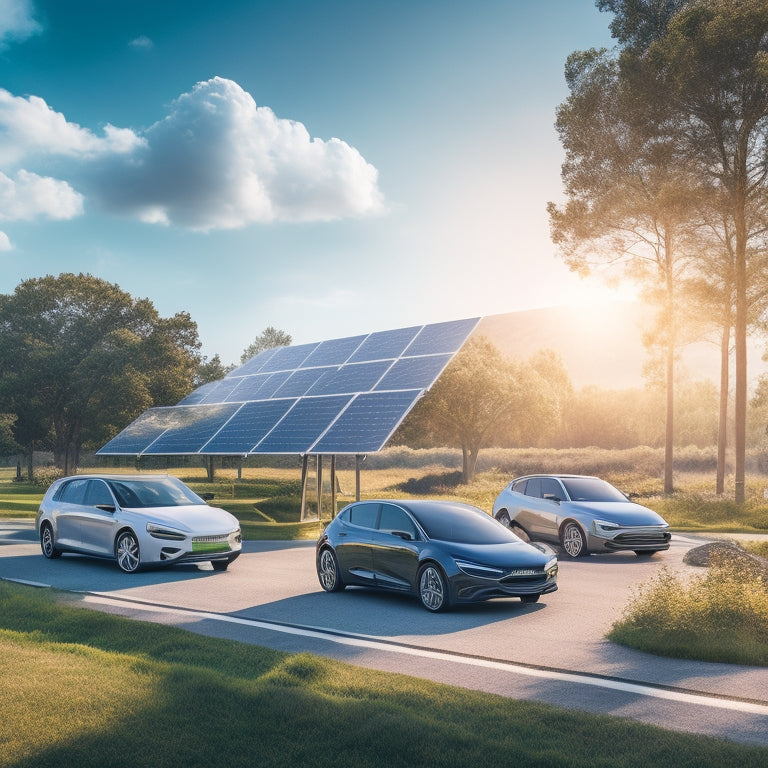
What's the Best Solar Solution for EV Fleets?
Share
You're examining a solar solution that meets your EV fleet's energy demands while minimizing operational costs and carbon footprint. Start by evaluating daily mileage, charging patterns, and energy requirements. Then, determine the ideal solar panel system configuration, considering module type, inverter size, and mounting structure. Don't forget to factor in energy storage systems, monitoring, and maintenance needs. As you weigh your options, consider the benefits of roof-mounted and ground-mounted solar arrays. You're just getting started on the path to optimizing your EV fleet's energy efficiency – and there's still more to explore.
Key Takeaways
• Assess daily mileage and charging patterns to determine the ideal solar panel system size and energy storage requirements for EV fleets.
• Consider roof-mounted or ground-mounted solar panel options, evaluating structural integrity, compliance, and energy production efficiency.
• Implement energy management strategies to optimize energy distribution, reduce peak demand, and minimize grid strain, ensuring reliable and efficient system operation.
• Choose a suitable system configuration, including ESS size, grid-tied or off-grid setup, battery chemistry, and inverter selection, to meet evolving energy demands.
• Conduct a cost-benefit analysis to determine the financial implications of solar adoption, including upfront costs, ongoing expenses, and available incentives like the Solar ITC.
Key Considerations for EV Fleets
When electrifying your fleet, you'll need to assess your vehicles' daily mileage, charging patterns, and energy requirements to determine the best solar solution. This evaluation is vital in ensuring your fleet's operational efficiency and minimizing downtime.
To begin, analyze your fleet's daily mileage to determine the required charging frequency. This data will help you identify the most suitable charging schedule for your vehicles.
Next, examine your vehicles' charging patterns to understand their energy requirements. This information will enable you to select the most appropriate solar panel system that meets your energy demands.
Effective fleet management is essential to a successful shift to electric vehicles. By understanding your vehicles' energy requirements, you can deploy them strategically to maximize their operational efficiency.
In addition, optimizing your vehicle deployment will reduce energy waste, lower operating costs, and minimize your carbon footprint. By considering these factors, you can create a tailored solar solution that meets your fleet's unique needs, ensuring a smooth and efficient change to electric vehicles.
Solar Panel System Requirements
With your fleet's energy requirements in hand, you can now specify the solar panel system that will effectively meet those needs, taking into account factors like panel efficiency, system size, and installation type.
When designing your system, consider the panel efficiency, which is vital in maximizing energy production. High-efficiency panels can generate more power per unit area, reducing the overall system size required to meet your energy demands.
In terms of system design, you'll need to decide on the ideal configuration for your fleet's charging infrastructure. This includes selecting the appropriate module type, inverter size, and mounting structure. Consider factors like shading, orientation, and local building codes to ensure a safe and compliant installation.
A well-designed system won't only meet your energy needs but also uphold the safety of your operations.
When specifying your solar panel system, be sure to evaluate the system's overall efficiency, taking into account losses due to temperature, wiring, and inverter inefficiencies. By carefully considering these factors, you can establish a reliable, efficient, and safe solar solution that meets your fleet's energy demands.
Energy Demands of EV Charging
Your electric vehicle (EV) fleet's energy demands are largely dictated by the charging requirements of each vehicle, which can vary greatly depending on factors such as battery size, charging speed, and usage patterns. To guarantee a reliable and efficient charging system, it's crucial to comprehend your fleet's energy demands.
Here are some key factors to ponder:
-
Charging frequency and duration: How often and for how long do your vehicles need to charge?
-
Charging speed and power: Do your vehicles require Level 2 (240V) or DC Fast Charging?
-
Vehicle usage patterns: Are your vehicles used for short trips or long hauls, and how does this impact charging needs?
-
Battery size and capacity: Larger batteries require more energy to charge, increasing your fleet's overall energy demands.
-
Peak demand management: Implementing strategies like load forecasting and peak shaving can help reduce strain on the grid and lower energy costs.
Roof-Mounted Solar Panel Options
By incorporating roof-mounted solar panels into your EV fleet's charging infrastructure, you can greatly reduce your dependence on the grid and decrease operational costs.
When selecting roof-mounted solar panels, consider the structural integrity of your building to guarantee a safe and efficient installation. Building codes and local regulations must be followed, so be sure to research and comply with these standards.
Evaluate your roof's condition, ensuring it can support the added weight of the solar panels. Take into account factors like wind load, snow load, and seismic activity to secure the structural integrity of your building. A thorough assessment will help you determine the most suitable solar panel configuration for your roof.
With the right installation, you can generate clean energy, decrease your carbon footprint, and enjoy significant cost savings. By prioritizing safety and compliance, you can establish a reliable and efficient solar-powered EV charging infrastructure for your fleet.
Ground-Mounted Solar Array Benefits
When you opt for a ground-mounted solar array, you'll appreciate the benefits it brings to your EV fleet's energy needs.
You'll have the flexibility to scale your system up or down as your energy demands change, and you'll enjoy lower maintenance costs thanks to easy access for repairs and cleaning.
Scalability and Flexibility
Installing a ground-mounted solar array allows you to scale up or down to match your EV fleet's evolving energy demands, guaranteeing a tailor-made clean energy solution that adapts to your operations' unique needs. This scalability is made possible by the modular design of ground-mounted systems, which can be easily expanded or contracted as your energy requirements change.
Some key benefits of this scalability and flexibility include:
-
Easy expansion: Add more panels as your fleet grows, ensuring you always have the energy you need.
-
System adaptability: Quickly reconfigure your system to meet changing energy demands or optimize energy production.
-
Reduced energy waste: Scale back energy production during periods of low demand, minimizing waste and maximizing efficiency.
-
Improved energy security: Guarantee a reliable energy supply, even during periods of high demand.
-
Future-proofing: Easily integrate new technologies or energy storage solutions as they emerge.
Low Maintenance Costs
Your ground-mounted solar array guarantees minimal upkeep, reducing your maintenance costs and freeing up resources for other critical aspects of your EV fleet operations. With fewer moving parts and no rooftop penetrations, the risk of damage or leaks is greatly diminished, ensuring a safe and reliable energy source for your fleet.
Predictive analytics and real-time monitoring enable proactive maintenance, allowing you to address potential issues before they become major problems. This proactive approach minimizes downtime and ensures your solar array operates at peak levels.
Additionally, extended warranties and thorough maintenance contracts provide an added layer of protection, giving you peace of mind and minimizing financial risks. By choosing a ground-mounted solar array, you'll enjoy lower maintenance costs, reduced downtime, and increased energy production – all of which contribute to a more efficient and cost-effective EV fleet operation.
Maximized Energy Production
By aligning your solar panels at ideal angles and directions, you can increase energy production by up to 25%, thanks to the flexibility of a ground-mounted solar array. This optimization enables you to harness more energy from the sun, ultimately leading to peak output.
When it comes to energy harvesting, every percentage point counts, and ground-mounted solar arrays offer a significant advantage.
Here are some benefits of ground-mounted solar arrays that contribute to maximized energy production:
-
Unobstructed Energy Harvesting: No shading or obstruction from nearby buildings or trees, ensuring maximum energy output.
-
Best Panel Orientation: Panels can be tilted and angled for best energy production, increasing overall efficiency.
-
Reduced Dust Accumulation: Easier cleaning and reduced dust accumulation on panels, ensuring consistent energy production.
-
Improved Cooling: Better airflow and heat dissipation, reducing thermal losses and increasing energy output.
-
Enhanced Monitoring and Maintenance: Easier access for monitoring and maintenance, ensuring prompt issue resolution and minimizing downtime.
Energy Storage System Integration
When integrating an energy storage system with your EV fleet's solar solution, you'll need to evaluate the system configuration options that best suit your operation.
You'll have to decide between AC-coupled, DC-coupled, or hybrid systems, each with its pros and cons.
Your choice will also depend on the energy management strategies you adopt to optimize charging, discharging, and grid interaction.
System Configuration Options
You can configure your energy storage system (ESS) to optimize your EV fleet's energy consumption and reduce strain on the grid by selecting from various system configuration options. These options allow you to tailor your ESS to meet your specific needs and guarantee a safe and efficient operation.
When configuring your ESS, consider the following options:
-
System Sizing: Determine the ideal ESS size based on your EV fleet's energy demands, ensuring you have sufficient capacity to meet peak energy requirements.
-
Grid Connection: Choose between grid-tied, off-grid, or hybrid configurations, depending on your energy independence goals and grid reliability.
-
Battery Type: Select from various battery chemistries, such as lithium-ion, lead-acid, or flow batteries, based on factors like cost, lifespan, and performance.
-
Inverter Selection: Opt for an inverter that matches your ESS's power output and guarantees efficient energy conversion.
-
Monitoring and Control Systems: Implement a monitoring system to track your ESS's performance, receive alerts, and optimize energy usage.
Energy Management Strategies
To optimize energy usage and minimize grid strain, an effective energy management strategy is essential when integrating an energy storage system (ESS) into your EV fleet's operations.
You'll need to contemplate how to manage energy distribution, consumption, and storage to guarantee a reliable and efficient system.
A well-designed energy management strategy can help you reduce peak demand, lower energy costs, and minimize the risk of brownouts or blackouts.
Monitoring and Maintenance Needs
Optimizing the performance of your EV fleet's solar charging infrastructure requires real-time monitoring and proactive maintenance strategies to guarantee maximum uptime and efficiency. As you oversee your solar-powered EV fleet, it's essential to stay on top of performance metrics, identify potential issues before they become major problems, and schedule maintenance to minimize downtime.
To guarantee seamless operations, consider the following key aspects of monitoring and maintenance:
-
Predictive Analytics: Leverage advanced data analysis to forecast potential equipment failures, allowing you to schedule proactive maintenance and reduce downtime.
-
Remote Oversight: Utilize remote monitoring systems to track performance, receive real-time alerts, and respond promptly to issues, ensuring swift resolution and minimizing the impact on your operations.
-
Automated Reporting: Generate regular reports to track key performance indicators, identify trends, and refine your maintenance strategy.
-
Scheduled Maintenance: Plan and execute regular maintenance tasks, such as cleaning solar panels, inspecting electrical connections, and updating software, to prevent faults and optimize performance.
-
Training and Support: Ensure your team receives thorough training and ongoing support to effectively monitor and maintain your solar charging infrastructure.
Cost-Benefit Analysis of Solar
As you evaluate the feasibility of integrating solar power into your EV fleet's infrastructure, a meticulous cost-benefit analysis of solar solutions is essential to determine the viability of this investment. A thorough analysis will help you assess the financial implications of adopting solar power and calculate your Solar ROI. This involves assessing the upfront costs of installing solar panels, inverters, and other equipment, as well as ongoing expenses like maintenance and repairs.
On the other hand, you'll need to contemplate the financial incentives that can offset these costs. For instance, the Solar Investment Tax Credit (ITC) can provide a significant tax credit for your business. Additionally, many states offer rebates and grants for businesses that invest in renewable energy.
Frequently Asked Questions
Can I Use Existing Electrical Infrastructure for Solar-Powered EV Charging?
'When you upgrade to solar-powered EV charging, don't assume your existing electrical infrastructure can handle the increased load. Conduct a thorough load analysis to determine if an infrastructure upgrade is necessary, ensuring a safe and efficient shift.'
How Do I Ensure Consistent Energy Output on Cloudy or Rainy Days?
You'll need to pair your solar panels with energy storage systems to compensate for cloudy or rainy days, and leverage advanced weather forecasting to optimize energy output and guarantee a consistent supply.
Are There Any Government Incentives for Solar-Powered EV Fleet Installations?
You're right to worry about the upfront cost, but don't let that hold you back! You can tap into Federal Grants and State Rebates, which can cover up to 30% of your solar-powered EV fleet installation costs, making it a more viable option.
Can I Use Solar Power for Both EV Charging and Building Electricity?
You can definitely use solar power for both EV charging and building electricity, leveraging energy storage systems to optimize excess energy and grid connection for reliable backup, ensuring a safe and efficient setup.
How Long Does It Take to Recoup the Investment in a Solar-Powered EV Fleet?
You're likely worried about the payback period, but with solar-powered EV fleets, you can expect investment returns in 5-7 years, depending on energy costs, usage, and local incentives, ensuring a safe and profitable venture.
Related Posts
-

3 Best Eco-Grants for Home Energy Upgrades
You're eligible for various eco-grants that can help you cut down on energy bills and reduce your carbon footprint by...
-

7 Solar-Safe Window Solutions for Earth-Conscious Homeowners
As an earth-conscious homeowner, you're likely keen to find solar-safe window solutions that align with your values. ...
-

3 Earth-Loving Furniture Tips for Energy-Smart Homes
When furnishing your energy-smart home, you have the power to reduce your carbon footprint greatly by making consciou...


